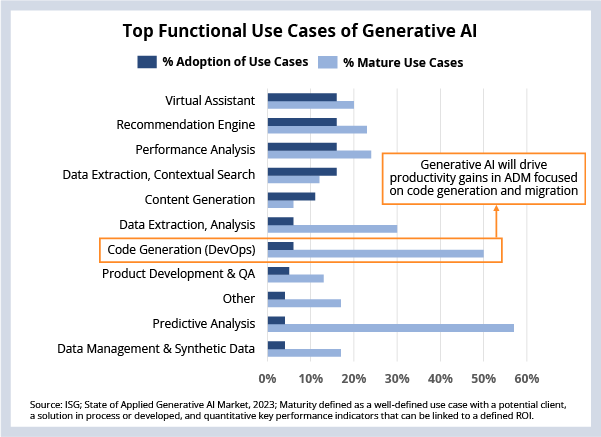If someone forwarded you this briefing, consider subscribing here.
GENERATIVE AI
Generative AI use cases are quickly maturing in areas like code generation and migration – two key areas in the application development and maintenance (ADM) service line. ADM is driving the lion’s share of the growth in the IT services sector today and makes up over 60% of all contract value. While this growth creates opportunities for providers, it will also translate into near-term pressure for providers to incorporate generative AI into their service delivery to stay competitive.
DATA WATCH

Generative AI Use Cases Abound
As we flagged on the 2Q23 Index call in April, generative AI use cases are emerging at light speed. We recently followed this up with an in-depth study focused on top trends, use cases and challenges related to adopting generative AI.
We encourage you to download a complimentary copy of the report. This is especially important for our enterprise readers, as there are some fantastic, practical recommendations on getting started and avoiding the inevitable “AI potholes.”
Let’s look at a specific example of generative AI’s impact on the IT and business services industry.
Generative AI and Code Development
As we discussed at our annual provider event last week, ADM is red hot. It now makes up over 60% of all outsourcing ACV and has grown 15% compounded annually over the past five years. ADM, plus vertical BPO and engineering, are what led the industry to its first-ever $10 billion quarter last quarter.
So, the question becomes: how will this new technology that can not only learn and repeat – but now create and re-create – impact the biggest and fastest growing part of our industry?
We believe we’ll start to see as early as 2024 improved – potentially significantly improved – productivity in apps-related contracts. And while providers have been automating for years, the twist here is that we may see providers pairing experienced developers with a “co-pilot” to boost performance. If this happens, it could start to impact many of the long-standing benchmarks that are used to measure ADM productivity, like application release rates, average build times and defect close rates.
So, while the actual number of use cases related to code generation in the research is not yet significant, the maturity of those use cases (in terms of delivering ROI) is high, indicating that – potentially – providers that integrate generative AI into their ADM offerings could see a real advantage in their ability to roll out more, faster, cheaper applications-related services for enterprise buyers. We already see several instances in which providers are building proprietary platforms (for internal use) to build AI-based applications faster.
If you’re interested in more detail on this topic, or on generative AI in general, download the report here, and feel free to reach out to Olga or me anytime.
